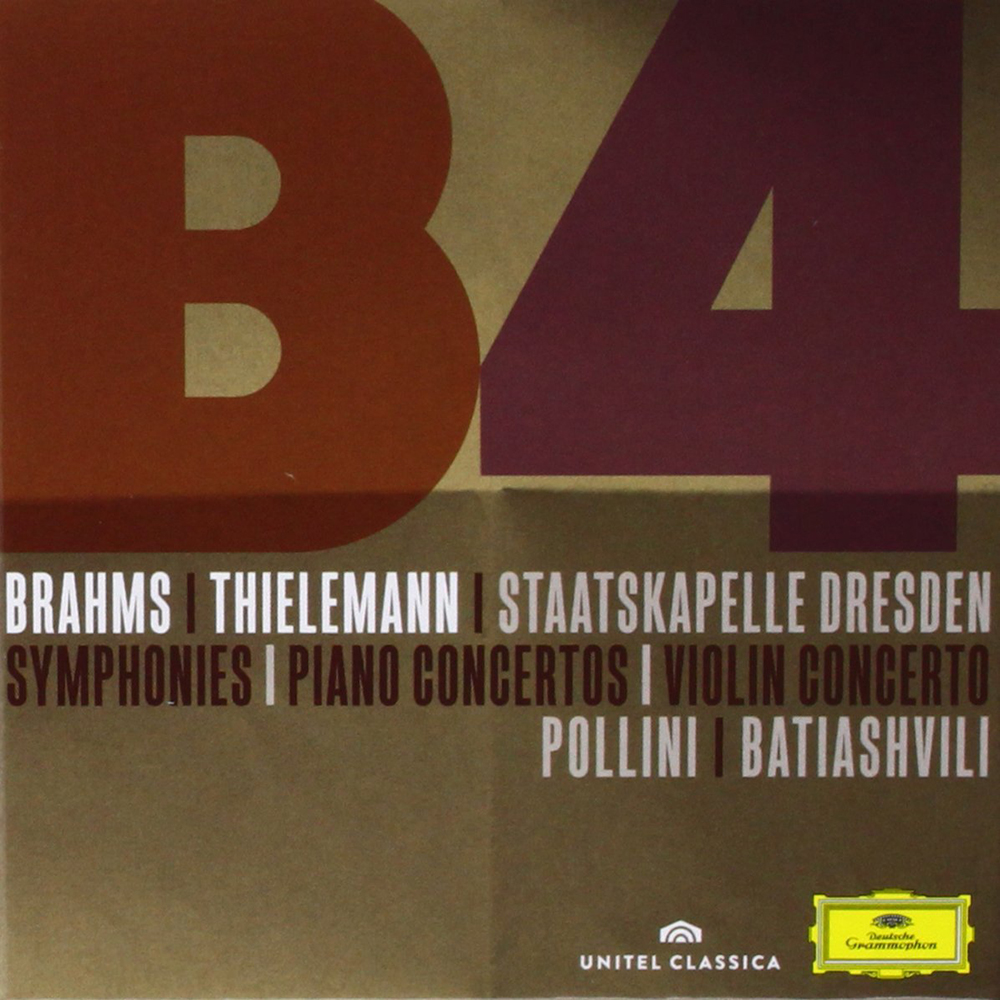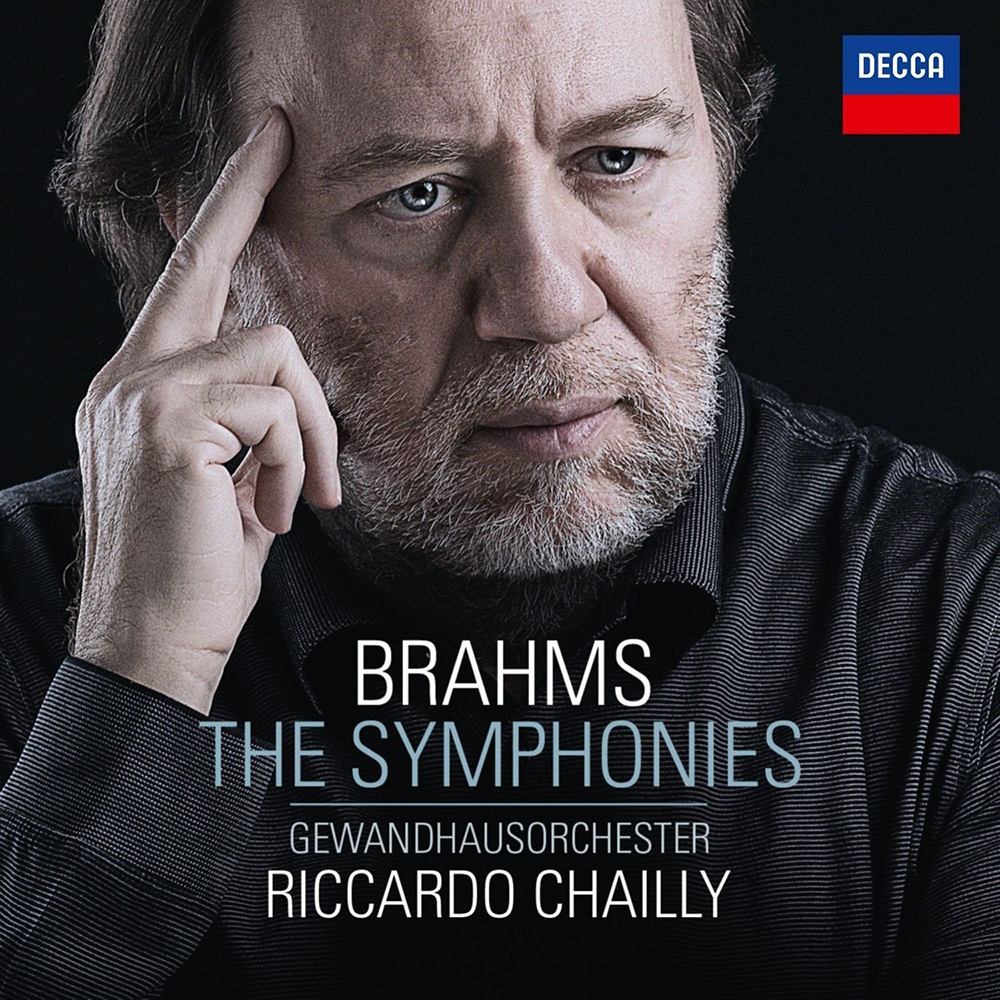
Violinist Lisa Batiashvili, and pianist Maurizio Pollini, and the Staatskapelle Dresden perform Brahms’ Symphonies 1-4, Tragic Overture, Academic Festival Overture, Violin Concerto and Piano Concertos 1 & 2. under the hand of German conductor, Christian Thielemann. (DG 3 CDs + 1 DVD 4792787 ) Total time: CDs: 194:30 / DVD: 146:54 (Available at Amezon.ca and iTunes)

Riccardo Chailly leads the Gewandhausorchester (Leipzig) in a performance of: Brahms: Symphonies 1-4. First version of Symphony No. 1 – Andante; Revised opening of Symphony No. 4. Tragic Overture; Academic Festival Overture. Variations on a Theme by Haydn; Two Intermezzi (orch. Klengel). Three Hungarian Dances (orch. Brahms); Nine Liebeslieder Waltzes (orch. Brahms). (Decca 478 7471) Total time: 234:04 (Available at Amazon.ca and iTunes)
+++
Most music-lovers and performers too take it for granted that they know pretty much what Brahms should sound like. No need for the historically informed folks to get involved. In fact, however, there are still issues to be considered and we do need to look at period performance practice. Neither of these new sets claims to be “historically informed” but one in particular – the Chailly with the Gewandhausorchestra – shows that a lot of thinking and research has gone into the preparation and rehearsal process.
Any conductor considering a performance of any of the orchestral works of Brahms needs to have read the authoritative 2003 book edited by Michael Musgrave and Bernard Sherman titled Performing Brahms: early evidence of performance style. (Cambridge University Press). It would also be helpful to refer regularly to Sherman’s website, www.bsherman.net. For example, here is a taste of Sherman’s views as recorded in his blog on Feb. 5, 2012:
In my last post, I noted that Norrington is wrong about vibrato. Brahms clearly expected vibrato from orchestral strings, and probably well varied and modulated vibrato at that. My own writings suggest that his “fast tempos” are largely a myth – what we know of Brahms’ tempi suggest that he often took slowish ones. And how about small ensemble size? Styra Avins demolished that one; Brahms preferred a large ensemble if it could play well…Norrington, Gardiner and Mackerras are giving us a modern style of Brahms playing. Turn to pre-war recordings by the likes of Adolf Busch, Clemens Krauss and Bruno Walter for a sense, at least, of period sound and style.
Echoing what Riccardo Muti said recently in a conversation we had in Chicago about Schubert style, Sherman notes that Bruno Walter said that the vibrato he heard from the Vienna Philharmonic in 1960 was essentially the same as what he had heard from the VPO in the 1890s.
Another very useful source is an essay by conductor Nicholas McGegan written in 2010 as he was preparing some Brahms performances with his Philharmonia Baroque Orchestra. His discussion of period instruments is especially insightful. It is worth noting too that on several key points his views are diametrically opposed to those of Musgrave and Sherman!
Of the two Brahms sets under consideration Thielemann is clearly the man closest to the spirit of these comments by Sherman, Walter and Muti. It is not hard to hear the tradition of Karajan, Böhm, Walter, and Furtwängler in his choice of tempi, articulation, tempo variation and weight of sound. Thielemann takes Brahms’ tempo markings as providing only general guidelines and he feels free to speed up or slow down as the mood takes him. Remember that Brahms hated the metronome and refused to put metronome markings in his orchestral works. We still debate whether Beethoven’s metronome markings are accurate but in Brahms case there can be no debate; there are simply no markings at all.
While I find the tempo fluctuations that Furtwängler makes in his Brahms performances are very often convincing, Thielemann’s are not. They seem affected and arbitrary.
Riccardo Chailly takes a very different approach. His view seems to be that if Brahms did not put a tempo change in the score then it would be presumptuous for a conductor to add one. The result is that Chailly’s performances sound fresh and new at first hearing but after a while begin to sound pedantic and tight. This is counterbalanced by playing of tremendous intensity but I still wanted to hear more flexibility in the tempi. We have plenty of ear-witness accounts from the period that Brahms himself often varied the tempi when he conducted his own works.
On the whole, however, the Chailly box is very impressive. The playing is crisp and well-balanced and if you like Chailly’s rigidity in matters of tempi there is not much to complain about. The performance of the Third Symphony is especially convincing. There is a tradition that the fourth movement should start more slowly than the tempo marking of Allegro would indicate. Many conductors maintain a slow tempo until letter B then move suddenly into a faster tempo. Chailly is Allegro all the way. And it works fine. The climax, when it comes, is very exciting. I also found the performance of the Academic Festival Overture to be wonderfully exuberant. The Thielemann performance pales by comparison. It seems devised to please the professors, while Chailly makes a direct appeal to the rowdy students.
The Chailly set also has some very unusual items. There is an alternative opening for the Fourth Symphony, based on a chord progression from the end of the first movement. It is brief but credible.
There is also an original version of the slow movement from the first symphony. An interesting look into the mind of the composer but ultimately not nearly as good as the later version. It is essentially the same music but the transitions are handled with much more logic and finesse in the final cut, as it were. According to the notes, for the original version of the Andante Chailly uses the same number of string players as in the Karlsruhe premiere: 10 first violins, 8 seconds, and four each of violas, cellos and basses. In otherwords, about half the number of players that would normally be used today to perform the Brahms First Symphony. But how many players did Chailly use for the final version of the symphony on his new recording? The notes by Peter Korfmacher don’t tell us. Although Chailly’s strings sound very lean my guess would be that he opted for string numbers somewhat higher than those cited for the Karlsruhe orchestra; perhaps 14/12/8/8/6. The original performing version of the second movement of the Brahms First was also recorded by Sir Charles Mackerras and the Scottish Chamber Orchestra in 1997.
There are orchestrations of two of the piano Intermezzi by Paul Klengel (1854-1935). Interestingly, Klengel was the brother of the principal cellist of the Gewandhausorchester and both were somewhat younger contemporaries of Brahms. Unfortunately, Klengel doesn’t succeed in convincing us that the Intermezzi make good orchestral pieces.
Brahms own orchestrations of nine of his liebeslieder waltzes are much more effective. The original scoring is for voices with piano four-hands. The orchestral versions have charm and nice touches of colour, especially for the horn in Op. 52 No. 9.
Thielemann is far more traditional than Chailly. Nearly all his tempi are slower than Chailly and the sound of his orchestra is more full-bodied. Chailly goes for tempi that he believes are more faithful to the score, and he brings a clarity to his Brahms that is almost unique. But if Thielemann’s approach is more to your taste you may find a lot to like in his new recordings. The Staatskapelle Dresden is a fine orchestra with a proud history. Among German orchestras I would rank it on a par with the Gewandhausorchester and with both of them somewhat below the rarified level of the Berlin Philharmonic and the Bavarian Radio Symphony.
It is rather odd that DG issued Thielemann’s Brahms set as a combination of CDs and DVDs. Why not all one format or the other? Be that as it may the DVD performances made a very strong impression on first hearing. Batiashvili gives one of the most impressive performances of the Violin Concerto I have heard for years. She makes a beautiful sound, she is always in tune, and her phrasing is wonderfully expressive. As a bonus, she plays the rarely-heard cadenza by Ferruccio Busoni in the first movement. When he transcribed his Violin Concerto for piano Beethoven wrote a cadenza that added the timpani as an accompanying instrument. This was unprecedented at the time. Busoni obviously liked the idea and borrowed it for the cadenza in Brahms Violin Concerto. Surprising, yes, but it works!
I wouldn’t have thought that Thielemann and Pollini would be ideal partners in the piano concertos. Thielemann has a touch of Furtwängler in his artistic makeup, while Pollini is more of a purist, and more objective in his approach. Thielemann is on his best behavior and at the age of 72 Pollini is still playing with technical mastery and authority. Pollini has recorded these concertos many times throughout his career – most recently with Abbado and the Berlin Philharmonic in the mid 1990s – and these latest versions confirm his stature as one of the great Brahms players of his generation. On the downside there is a certain lack of spontaneity in these performances. Pollini seems to see Brahms as a humourless old fogey. But for me Brahms was a passionate man who loved nothing better than to tease the poetry out of a phrase. Unfortunately, there is neither passion nor teasing in Pollini’s playing. I don’t sense that there is much curiosity either. Twenty years went by between Pollini’s recording of the D minor concerto with Abbado and the present one with Thielemann, and yet the timings for each of the movements are within seconds of each other. On the positive side one must admit that if nothing else Pollini is a model of consistency.
http://www.amazon.ca/Brahms-Symphonies-CD-Set-price/dp/B00E6G23TA
- SCRUTINY | TSO Lets Berlioz Do The Talking In Season Opener - September 21, 2018
- RECORD KEEPING | Even Yannick Nézet-Séguin Can’t Make Us Love Mozart’s La Clemenza di Tito - September 6, 2018
- RECORD KEEPING | Giovanna d’Arco With Anna Netrebko Explains Why The Best Operas Survive - August 30, 2018



